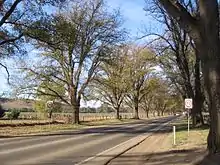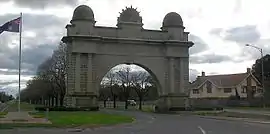Avenue of honour
In Australia, an Avenue of Honour is a memorial avenue of trees, with each tree symbolising a person. The tradition, which originated in the Goldfields region of Victoria, Australia, is an important part of Australian culture. There are 547 known avenues of honour in Australia, in all states and territories except the Northern Territory. Over half are in Victoria.[1]

Most avenues are in remembrance of those who fought or died in war, particularly World War I (1914–1918), although the earliest recorded avenues were planted in remembrance of Australia's participation in the Second Boer War (1899-1902).[1] Since soldiers were grouped by the place they were recruited, a military defeat often meant all of the men of eligible age from the town were killed in the same battle. Many of the avenue's trees include metal plaques naming the victims.
Many of these avenues now feature large, established trees and exotic species.
Several of these avenues are listed on the Victorian Heritage Register; most others are afforded local levels of heritage protection through the various Local government in Australia and the National Trust of Australia; however, many such avenues have since been affected by road development.
An online project titled "Avenues of Honour 1915-2015" (www.avenuesofhonour.org) has been established by Treenet, the urban tree research and education organisation based at the University of Adelaide's Waite Arboretum.[1]
State significant avenues

- Ballarat — The longest (22 kilometres and 3,912 trees) of the Avenues of Honour, made ever grander by its Arch of Victory.[2][3]
- Bacchus Marsh Road — The avenue of Dutch Elm trees serves as a tribute to local people who enlisted in the First World War. The 281 trees were simultaneously planted on the call of a bugle in 1918.[4][5]
- Eurack[6]
- Macedon-Woodend Road, Shire of Macedon Ranges[7]
Other Victorian Avenues of Honour
- Anglesea – relatively unusual in that flowering gums (corymbia ficifolia) were planted. Seventy-two trees were planted but only three or four remain.[8]
- Ballarat East — A second lesser known Avenue of Honour once marked the eastern entrance to Ballarat at Victoria Street. A handful of trees remain on one side of the road, the rest having been demolished, most during construction of the rail flyover in the 1960s.
- Macedon[9]
- Booroopki[10]
- Buchan South[11]
- Daylesford
- Hotspur[12]
- Kongwak
- Lakes Entrance[13]
- Lysterfield[14]
- Wandin North - also planted with flowering gums.[15]
- Woodend North
- Ballarat Orphanage's Arthur Kenny Avenue[16]
Avenues of Honour outside Victoria
- Yungaburra, Queensland[17]
- Manly Vale, Sydney, New South Wales – established in 2005 to commemorate the service and sacrifice of Merchant Navy personnel in two world wars.[18]
- Cowra, New South Wales[19]
- O'Connell, New South Wales
- Albany, Western Australia
- Armadale, Western Australia
- Kings Park, Western Australia - May Drive, Lovekin Drive and Marri Walk [20]
- Hobart, Tasmania
See also
References
- Megan Backhouse, "Felled but not forgotten", The Saturday Age, 8 June 2013, p. 10
- "VHD". Retrieved 17 December 2016.
- Ballarat Avenue of Honour Archived 2014-04-13 at the Wayback Machine
- "VHD". Retrieved 17 December 2016.
- "Bacchus Marsh Avenue Of Honour - Homepage". Retrieved 17 December 2016.
- "VHD". Retrieved 17 December 2016.
- "VHD". Retrieved 17 December 2016.
- "Anglesea Avenue of Honour". Heritage Victoria. Retrieved 23 July 2014.
- "Quercus palustris". National Trust. Retrieved 23 July 2014.
- Borookpi Avenue of Honour Archived 21 August 2006 at the Wayback Machine
- Buchan South Avenue of Honour Archived 14 March 2011 at the Wayback Machine
- Hotspur Avenue of Honour Archived 12 July 2006 at the Wayback Machine
- Lakes Entrance Avenue of Honour
- Lysterfield Avenue of Honour Archived 23 August 2006 at the Wayback Machine
- "Avenues of Honour Map". Avenues of Honour 1915-2015 Project. Archived from the original on 28 July 2014. Retrieved 23 July 2014.
- The Re-Discovery of Ballarat Orphanage's Arthur Kenny Avenue: Commemorative Booklet (Friday 9 November 2012)
- "Avenue of Honour :: Home". Retrieved 17 December 2016.
- "King St Avenue of Honour". Register of War Memorials in NSW. Retrieved 23 July 2014.
- Cowra Avenue of Honour
- "Botanic Gardens and Parks Authority - Honour Avenues Map". Retrieved 17 December 2016.
Further reading
- Haddow, Janine (1987). Avenues of Honour in Victoria (Master of Landscape Architecture). University of Melbourne.
- Taffe, Michael. Victoria's Avenues of Honour to the Great War Lost to the Landscape. (Bachelor of Arts Hons). University of Melbourne. 2006.
- Taffe, Michael. '90th Anniversary of our Avenues of Honour', Australian Garden History Journal p.24, Vol.17 No.5 May/June 2006.
- Taffe, Michael. “A New Nation – A New Landscape: Victoria’s Great War Avenues of Honour.” Paper presented at the Australian Garden History Society 2012 Conference. https://www.gardenhistorysociety.org.au/wp-%5B%5D
- Taffe, Michael. “Keeping Memory Green.” Historic Gardens Review 32 (2015): 18–21.
- Taffe, Michael. First World War Avenues of Honour: Social History through the Landscape. (PhD Thesis) Federation University, Ballarat. 2018.
